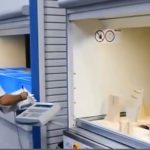Satellites are getting smaller, cheaper, and more complex – it really is rocket science, and its changing the world. FINN’s editor-in-chief Alan Peaford and space correspondent Steve Nichols look at how technology developments are changing the world.
The satellite industry’s pace of development has been breathtaking, ever since Sputnik 1’s shock arrival into space in 1957. Back then all Sputnik could do was send a “beep-beep-beep” radio message back to Earth.
Nowadays Earth-observation satellites keep an Eagle eye on the planet 24/7, while telecommunications satellites are bringing internet access to places you could only have dreamt of a few years ago, including aircraft.
Inmarsat’s Global Xpress (GX) satellite fleet, for example, can deliver internet to aircraft passengers at speeds that almost match the experience they get on the ground.
Its GX network powers boasts major airline customers, including Lufthansa, Qatar Airways, Air New Zealand, Singapore Airlines, AirAsia, Norwegian, Avianca, Austrian Airlines, Eurowings, Citilink, Garuda and Philippine Airlines.
The company’s four Ka-band geostationary satellites currently provide worldwide coverage up to around 80-degrees North and South latitude. Inmarsat has plans to increase that even further with two further satellites that will provide polar coverage using highly-elliptical orbits (HEO).
Scheduled to launch in 2022, GX10A and 10B will be the first satellites in the GX network to be placed into HEO.
The network also powers Inmarsat’s Jet ConneX inflight broadband solution, which has already been installed on more than 500 business aviation aircraft across the world.
Small satellites will revolutionise internet connectivity
Small satellites are also revolutionising internet connectivity. OneWeb is gearing up to provide internet access across the whole planet via a constellation of low-Earth orbiting satellites.
The advantage of low-Earth orbits compared with geostationary is reduced latency – the time delay from sending a signal to receiving it.
The OneWeb company, based in White City, London, already has 40 satellites in orbit and is set to launch between 32-36 per month. Its aim is to have a total of around 650 satellites by the service’s commercial launch in Q4 2021.
The satellites will operate in circular low Earth orbit, at approximately 750 miles (1,200 km) altitude, and transmitting and receiving in the Ku-band radio frequency spectrum.
OneWeb promises high-speed services at speeds of more than 400 Mbps, enabling the fastest real-time video streaming in full HD from space.
The company’s aim is to provide internet access to “those that are currently disconnected”. But it has plans to go much further, encompassing aviation, shipping and much more.
Earth-observation satellites detect changes on the planet
Meanwhile, Earth-observation satellites are jam-packed with sensors that can detect everything from minute changes in gravity, to tiny shifts in the land caused by earthquakes.
For example, UK-based Earth-I is a geospatial intelligence company offering automated crop detection, mapping and health monitoring services to clients in the agriculture industry.
Its satellite data is being used to help coffee farmers in Kenya. Knowing when to fertilise or when to spray chemicals, helps farmers maximise yields and enhance the quality of the beans.
Earth-I combines satellite imagery from the DMC-3 satellite, built by SSTL in Guildford, with machine learning and artificial intelligence to help farmers make more effective crop management decisions in the face of the impact of climate change.
SSTL has made quite a name for itself in the small satellite world. Originally a spin-off from the University of Surrey, SSTL now boasts a 40 per cent share of the global export market.
In the late 1970s, a group of researchers working at the University decided to experiment by creating a satellite using commercial off-the-shelf (COTS) components. The idea was bold and audacious and the results were surprising.
In 1985 Surrey Satellite Technology Ltd was formed as a spin-out company to transfer the results of research into a commercial enterprise. In 2009 Airbus bought the majority shareholding from the University of Surrey, allowing SSTL to fulfil its growth potential. SSTL is now an independent company within Airbus.
More than 60 SSTL satellites have been launched, ranging from the lightest at 3.5kg to the heaviest at 3500kg.
SSTL has been working on low-cost synthetic aperture radar (SAR) solutions for many years and in 2018 launched NovaSAR-1, a 450kg low-cost S-Band SAR technology demonstration mission.
SAR permits all weather Earth observation, irrespective of time of day or night.
Example applications include disaster monitoring and management, urban planning, transport management, ship identification and tracking, and high temporal constellation-enabled monitoring for security and environmental risk management.
Small satellite launches are a growing market
SSTL made the right choices – small satellite launches are a growing market. A Frost and Sullivan report said that by 2030 the total projected launch capacity supply, including the success of multiple dedicated, planned launch services, would be 11,746 small satellites.
The UK has ambitious plans for small satellite launches. The UK Space Agency has awarded £1.3 million to help further develop plans for horizontal-launch spaceports in Wales, Scotland and England, including almost £500,000 for the Snowdonia Spaceport Development Plan.
Nearly £500,000 is going to Machrihanish Airbase Community Company for the spaceport cluster plan in Argyle, Scotland, centred on an aerodrome with the longest runway in Scotland.
Satellite launches have traditionally been expensive – they can typically account for a third to one half of the total cost of a small satellite mission. But it is getting cheaper. Whereas a large satellite launch in the 1990s might have cost upwards of $60 million, SpaceX says its new service could launch a 200-kilogramme small satellite for just $1 million.
Virgin Orbit to launch from Spaceport Newquay
Over the next year or so we should also see Virgin Orbit lofting satellites into space, first from the USA and then from Spaceport Newquay in Cornwall.
Virgin Orbit’s air-launched LauncherOne rocket will be carried aloft underneath a modified Boeing 747 before being released at about 50,000ft. A two-stage rocket engine will then ignite, taking the launcher and its payload on into space.
The UK Government aims to grow its global market share of the space sector to 10 per cent by 2030. Its vision is for the UK to be at the global forefront of small satellite launch and emerging space transportation markets – bringing new markets to the UK and inspiring the next generation of British space scientists, engineers and entrepreneurs.
Across the world benefits of the advanced technologies are being seen. Earlier this month, on March 17, forecasters at NASA’s Joint Typhoon Warning Center (JTWC) noted “infrared satellite imagery indicates a sharp intensification trend over the past 12 hours as the system formed an irregular 13-nautical mile wide eye.” This unusual trend – backed by a pin sharp imagery – enabled preparations to be in place around the island of Mauritius.
Further afield, NASA is also supporting projects to develop small satellites that could orbit the Moon as part of the return to the Moon by humans. The satellites will supply imagery to support exploration.
Countries around the world are developing their own satellite businesses – only this month Egypt announced its own Satellite City for it new space industry.
But there is a bigger challenge ahead.
900,000 pieces of space junk in orbit
While here on Earth we struggle to clean up the environmental mess, the space industry is becoming concerned about the growing space pollution hurtling around our planet due to inactive and defunct spacecraft and satellite parts, ranging from the size of a truck to specks of paint.
NASA is currently tracking 500,000 pieces between 1 and 10 centimetres in diameter. But the latest figures show there are 900,000 pieces debris ranging from 1 cm and 10 cm and 128 million fragments between one millimeter and one cm. There are also 5,000 satellites orbiting Earth, of which only 3,000 are active.
With more on the way, there is a need for technology firms to begin planning the systems to clean up the mess and remove abandoned space clutter.
Now that really is rocket science!

